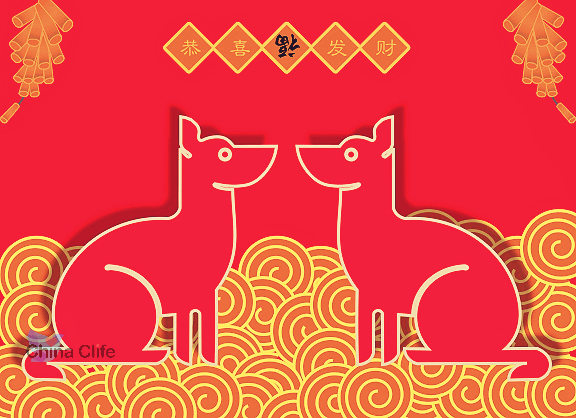"2018 is called the year of Dog or dog year in China. This article will introduce you the concept of Chinese dog year. Lets jump to the following contents."
THE YEAR OF DOG 2018
| 狗年
English Words: Year of Dog or Dog Year Chinese Pinyin: Gǒu Nían Chinese Characters: 狗年
What is the "Dog year" in China?
Unlike the start of the New Year in Western countries, Chinese Lunar New Year always took on the first day of the first lunar month. But the date varies different from year to year, according to the traditional Chinese calendar.
In ancient and in the traditional Chinese lunar calendar, time was counted by twelve as a unit, such as every 12 years divided as a cycle, an ordinary year dividing into 12 months, an ordinary month into 12 hours (in ancient). Each of 12-year, 12-month, and 12-hour is represented by one of 12 zodiac animals, namely the Chinese Zodiac. Each 12-year is a circle, so are the Chinese zodiac animals, and so on.
Based on the Chinese lunar calendar, the date February 26, 2018, is the first day of the next coming Chinese traditional new year. In Chinese traditional culture, dogs are used to represent this year, which is the top 11th animal in Chinese Zodiac, another called “Xu Dog”. As for 2019, it is associated to the twelfth animal “Pig”, which also marks the end of a cycle. After the end of 2019, a new round of the Chinese Zodiac should begin to use again.

(Dog year 2018, Chinese new year 2018, lunar new year 2018)
Why do Chinese call 2018 as a "Dog year"?
In ancient of China, in order to allow all common people to remember years (especially their birth year), including those living in ancient grottoes, those who did not take any education due to less of money, hard to read or write anything, then Chinese people create the most simple way to mark each year —— using 12 kinds of animals. Later it was called the Chinese Zodiac Signs of Years.
Chinese Zodiac in Chinese/Mandarin is: 生肖 (Shēng Xiāo)
生 (Shēng) in Chinese means: was born; birth
肖 (Xiāo) in Chinese means: similar (to)
The 12-year cycle zodiac signs vary from Rat, Ox, Tiger, Rabbit, Dragon, Snake, Horse, Goat, Monkey, Rooster, Dog to Pig. It contains a very wide range of mammals, reptiles, birds, and beasts, and even the animal in legend, the Chinese totem — Dragon.
The Chinese Zodiac is originated from Xia Dynasty (About 2000 ~1600 BC), and then formed in Han Dynasty (About 202 BC) and widely used later. By the year of 2018, it will be the eleventh animal Dog's turn. Therefore, 2018 is widely called “Dog year” in China.
Due to the coming new year, various arts of dogs are created. Dog and other eleven animals are becoming very popular symbols and mascots of each new year, even used frequently in various entertainments and cultural celebrations.
What usages of the Chinese Zodiac (Dog and other 11 animals)?
In addition to calculating years/months/hours, in ancient of China, people also like to use the Chinese zodiac to calculate the age of a person. Each Chinese people could use the animal sign of his birth year as to be his own symbol. It is because that people always thought a person would have some personalities similar to the characteristics of his birth year’s animal. Thus numerous folk tales and stories related to the Chinese zodiac were created, year over year, mouth to mouth.
Until now, the Chinese zodiac has become one of the most precious oriental cultures and has gradually merged with many kinds of Chinese beliefs, often associated with a human being's destiny, personality, fortune, and marriage. It also becomes the image of philosophy in Chinese folk and culture, which also make the Chinese culture more interesting and mysterious.
What does Dog mean to Chinese and Chinese Culture? Why?
- In ancient China, a dog was one of the six domestic animals and to be domesticated earlier than other.
- In traditional Chinese culture, a dog is not only an animal but also a symbol sometimes.
- In Chinese legend, there are too many stories related to dogs, such as dogs which saved master, repaying the kindness, appealing for justice, and even dogs exorcism. “Howling Celestial Dog” (Called Xiào Tiān Quǎn in Chinese),the loyal dog accompanied the famous Chinese god “Erlang Shen”, is just one of the top famous and classic dog image in Chinese culture. It is a mystical traditional Chinese hound which has the ability to attack and subdue Demons. This ferocious hound helped its master when he was fighting Sun Wukong, by biting him on the leg. It can also howl and roar ferociously, releasing deafening and destructive Shockwaves that can shake even Heaven and Earth as it does so, hence giving it this name.
- In ancient times, most of the Western ethnic groups were nomads, and sheepdogs were very important to nomad people in daily life. Thus, sheepdogs were their friends. But in ancient of China, most focused on farming culture. Referring to farming civilization, the most important assistant is the ox, the plough ox, not the dog. So although both of them were added to the Chinese zodiac, their symbolism is quite different. In China, the ox represented the features like hard-working, solid and pragmatic, while dogs were more often to be domesticated by rich people as house guardians, not as pets. Such dogs were probably quiet and friendly to the families, but vigilantly and unfriendly to strangers.

- In the view of Chinese, dogs always symbolized wealth and fortune. In the traditional culture, dogs are always auspicious animals. If a dog came occasionally into one’s home, the master will be very happy to adopt it, because it indicates the fortune will come also. There’s an old saying that, “cats coming to the poor, dogs coming to the rich”.
- Dogs share the joy and suffer pain with masters together. If any disasters approaching, the dog will give indications. For example, if a dog jumping to the roof, it probably tells you that the thieves are approaching. Dogs always like barking and roaring, and people thought there must be some reason for that. Thus the ancients also took the barking hour to predict if it is the good or bad sign.
- In Chinese accent, the word “汪” describing the barking of dogs sounds as the same as another word “旺” which means lucky, wealthy and happy. Thus, to call it “year of dog” is to present good willings of a better and lucky new year. Chinese young people are also used to call dogs with an interesting name “Wealthy” (旺财 Wàng Cái). As the new year’s coming, the dogs' elements and related art creations are appearing almost everywhere in China.
A smiling dog, not only represents the harmonious relationship between dogs and human beings but also shows Chinese people’ expectations and willings, that " any unhappiness could go away, good luck comes instead and happy every day" in the new year.
More Stories To be Continued and wish you a happy "dog year"! : )
All content on this page, including but not limited to text, images, photos, audios, videos, are all subject to copyright and other intellectual property protection, and should NOT be copied or reproduced in any manner whatsoever without prior written permission from the author or authors.
Some of image or photo materials might be sourced from the Internet the copyright of which might belong to its original creators as same as the signatures offered. However, some sources could not find the original creators. If you find your creation appeared on our website without your authorization, please contact us immediately, we will delete it in 48 hours or put your name on your creation as soon as possible after confirmation. We do apologize for such a case if it might happen. However, we do not accept any legal liability and legal duty. Thank you for your understanding.


[…] Year of Dog 2018 | 狗年 | Gǒu Nían […]
[…] Learn Chinese: Year of Dog 2018 | 狗年 | Gǒu Nían […]